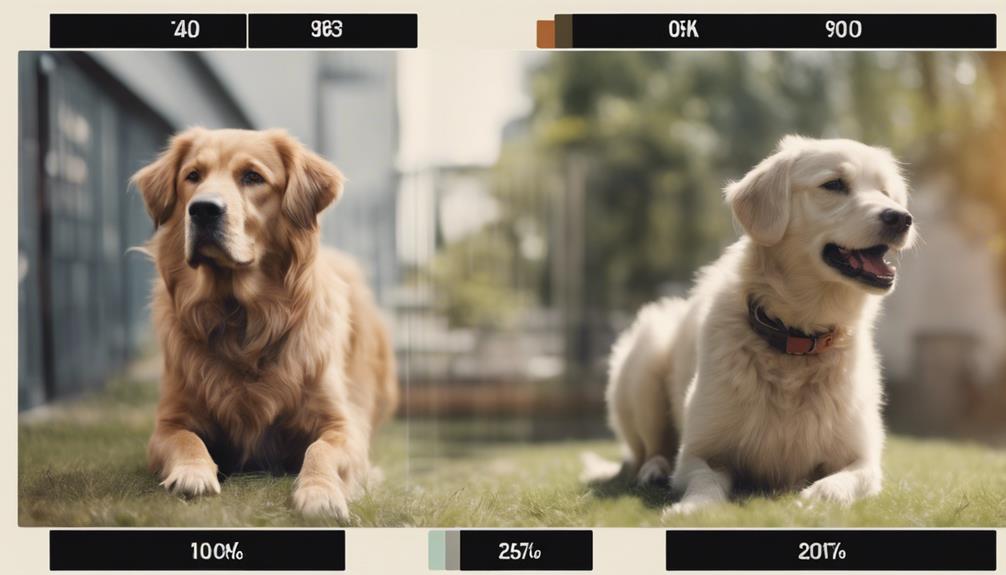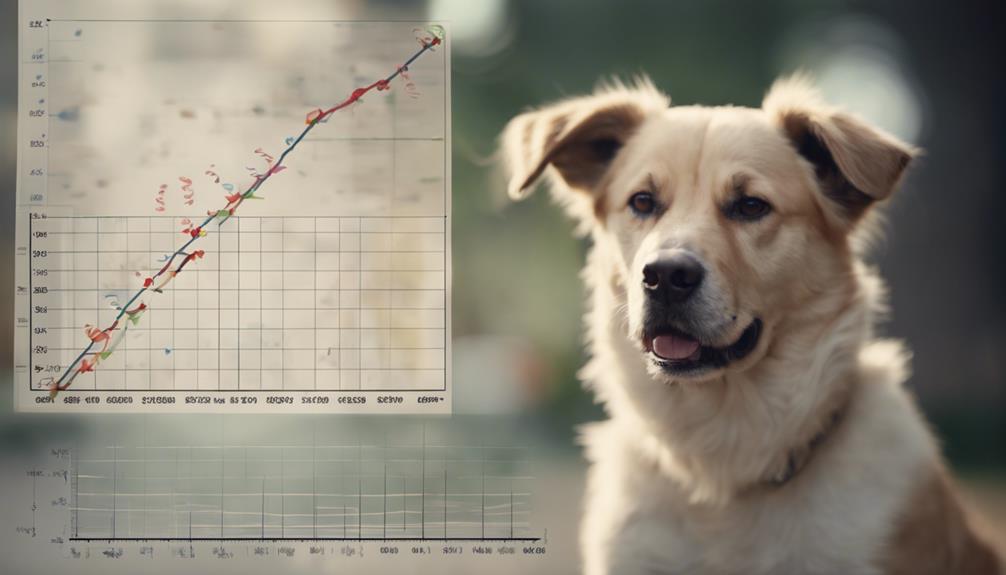Unveiling the true age equivalence of our canine companions in human years requires a departure from the conventional rule of thumb. The simplistic notion of multiplying a dog's age by seven fails to capture the intricate aging process that our furry friends undergo.
By exploring the nuanced factors that influence how we calculate our dogs' ages, we can gain a deeper understanding of their developmental journey. Size, breed, and other variables play a crucial role in discerning the real way to determine a dog's age in human terms.
Stay tuned to unravel the mysteries behind this complex age calculation and gain a new perspective on your dog's true chronological age.
Key Takeaways
- Dog aging defies direct conversion to human years, with the first year akin to human adolescence.
- Size and breed significantly influence the aging process, impacting when dogs reach senior status.
- Understanding age equivalence based on size and breed aids in estimating a dog's age accurately.
- Different breeds age at varying rates, with Great Danes becoming seniors around 7 years and Chihuahuas at around 11 years.
Dog Aging Process Overview
Exploring the intricacies of dog aging reveals a process that defies the simple conversion of years into human equivalents. Unlike the common belief of multiplying a dog's age by seven to determine its human equivalent, a more nuanced understanding is required.
The initial year of a dog's life can be likened to human adolescence, with the second year bringing them close to full physical maturity while mental maturity may still be developing. Factors such as size and breed play a crucial role in the aging process, with Great Danes considered seniors at around 7 years old, and Chihuahuas reaching senior status around 11 years old.
Understanding these nuances is essential for accurately gauging a dog's age and tracking its aging journey.
Impact of Size and Breed
Considering the impact of size and breed on a dog's aging process reveals significant variations in their life stages and age equivalency. These factors play a crucial role in understanding your dog's development and determining the appropriate care they require.
Here are some key points to consider:
- Great Danes are considered seniors at 7 years old.
- Chihuahuas may reach senior status around 11 years old.
- Size and breed influence the aging process.
- Different breeds have varying lifespans.
Dog Age Equivalence Chart

Understanding a dog's age equivalence through the implementation of a dog age equivalence chart is a valuable tool in accurately estimating a dog's age in human terms. The chart below provides a rough guide to help you determine your dog's age in human years based on their actual age:
| Dog's Age (Years) | Human Age Equivalent |
|---|---|
| 1 | 15 |
| 2 | 24 |
| 3 | 28 |
This age equivalence chart serves as a useful tool for tracking your dog's aging process and identifying when they reach specific life stages. By utilizing this chart, you can gain a better understanding of your dog's age in relation to human years.
Size and Breed Influence
The impact of size and breed on a dog's aging process is significant and plays a crucial role in determining their age equivalence in human years. Understanding how size and breed influence aging can help dog owners better care for their pets and anticipate their needs as they grow older.
- Great Danes are considered seniors at 7 years old.
- Chihuahuas may reach senior status around 11 years old.
- Size and breed influence the aging process.
- Different breeds have varying lifespans.
Understanding Age Equivalence

Size and breed significantly impact a dog's age equivalence, providing valuable insights into their overall aging process. Different breeds age at varying rates, with larger breeds often reaching senior status earlier than smaller breeds. For example, Great Danes are considered seniors at around 7 years old, while Chihuahuas may not reach senior status until they are around 11 years old. Understanding the size and breed of a dog is crucial in determining their age equivalence.
This knowledge helps in accurately estimating a dog's age in human terms using age equivalence charts. By utilizing these tools, owners can better track their dog's aging process, identify when they reach specific life stages, and provide appropriate care tailored to their age.
Related Dog Care Articles
Delve into a diverse range of topics in dog care with a selection of informative articles. Explore valuable insights into feeding, breed specifics, and health concerns to ensure the well-being of your canine companion.
Here are some related dog care articles:
- How Much Should I Feed My Dog?
- Everything You Need to Know About Puppy Feeding
- Embark Pauses Sale of Dog Age Tests Due to Inaccuracy
- Updates on Terms of Service and Newsletter Sign-Up
Stay informed on essential aspects of dog care, from nutrition to age determination, and be equipped to provide the best care for your furry friend. Engaging with these articles will enhance your understanding of proper dog care practices.
Conclusion
In conclusion, the age equivalence of dogs in human years is a complex and multifaceted process that requires consideration of various factors such as size, breed, and developmental trajectories.
By utilizing a dog age equivalence chart and understanding the nuances of age calculation, we can gain valuable insights into our canine companions' aging progression and better monitor their health and well-being.
This analytical approach allows us to appreciate the temporal dimensions of our dogs' lives and the milestones they reach on their evolutionary journey.




